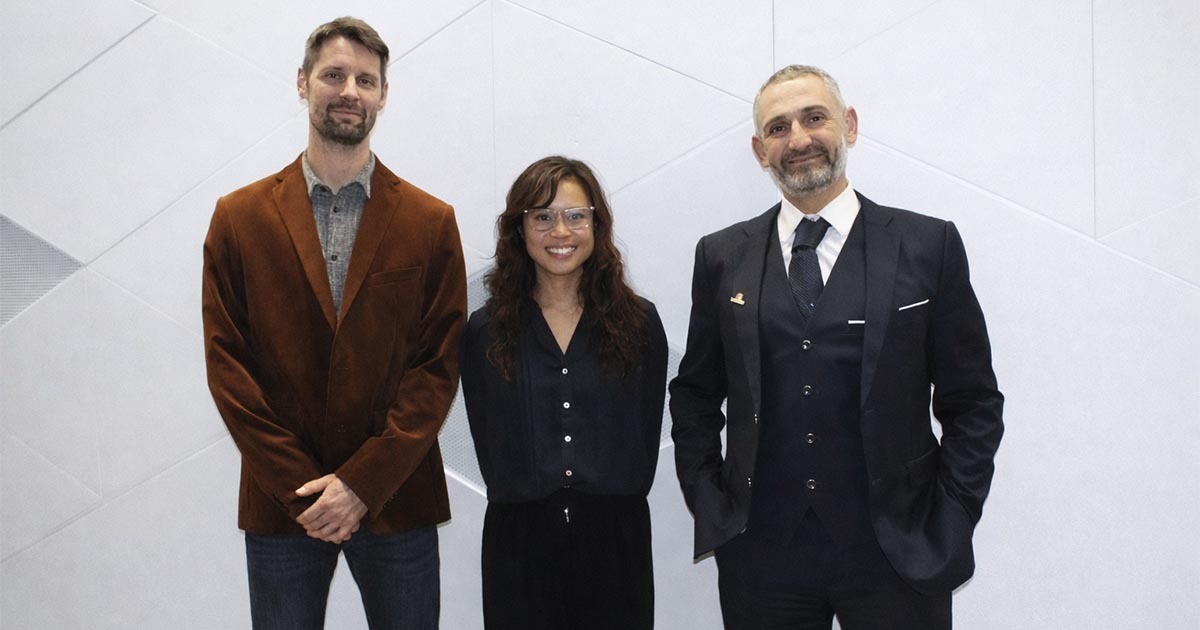A Magnetic Field Sensor at the Crossroads of Photonics and Magnetic Fluids
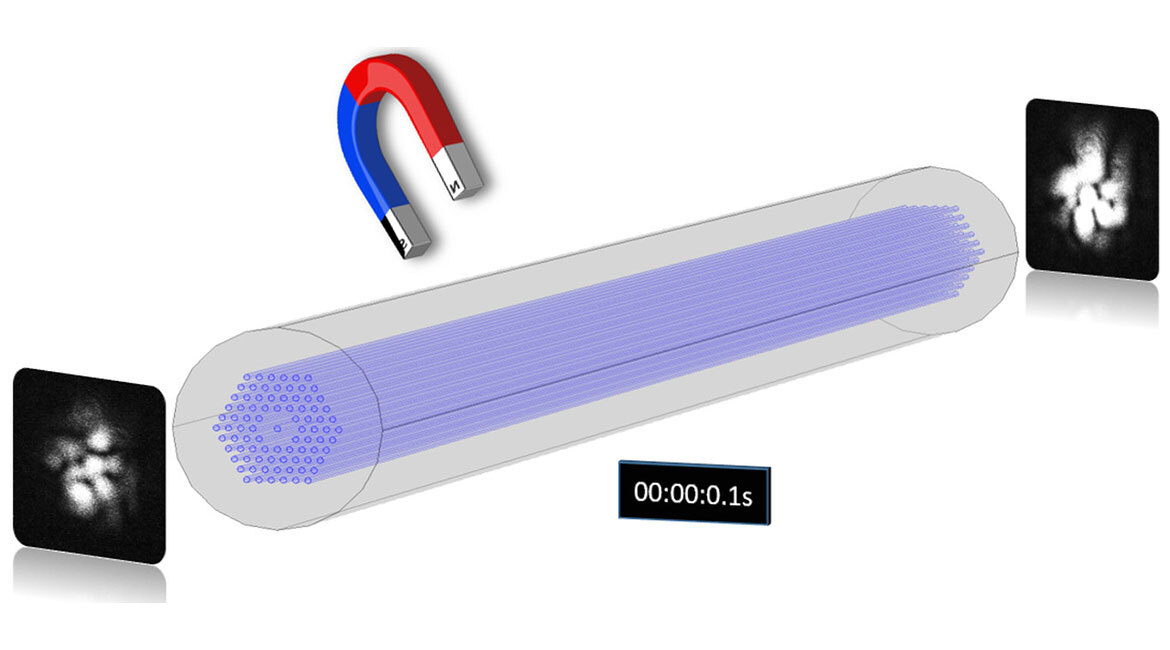
The image was provided by Saeed Azad.
Introduction
Magnetic field sensors have been extensively used in electric current measurements, in metallurgy, the power industry, biomedical detection, oil & gas exploration and the aviation industry1,2. Compared to conventional sensors, optical fiber-based magnetic field sensors offer promising key benefits, such as a compact size, immunity to electromagnetic interference, remote monitoring, high reliability and sensitivity. Meanwhile, with the growth of nanotechnology and the advent of liquids functionalized with nanoparticles, emerging applications of so-called magnetic fluids (MF) are being studied in the sensing field. MF is a liquid typically composed of single-domain magnetic nanoparticles (MNPs) coated with a surfactant in suspension within a liquid carrier. Accordingly, different configurations of optical fibers in conjunction with MF have been well studied as magnetic field sensors. Fabry–Pérot-based sensors that incorporate MF within a section of optical fiber suffers from sensitivity to thermal expansion and a complicated fabrication process3,4. In this work, by injecting the MF inside the fiber, the original microstructured features are not only preserved, but the whole fiber also offers an extended sensing area that enhances sensitivity5.
Sensor Fabrication
The experimental testing setup is depicted in Fig. 1. The incident light from a near-infrared laser source (λ=976 nm, Thorlabs, Pigtailed Butterfly Package) was coupled to the PCF through a combination of objective lenses. A linear polarizer was tuned so as to optimize the interaction of light with the MF6. The MF was successfully infiltrated into the air holes based on Poiseuille’s law7. Fig. 1b shows the scanning electron microscopy (SEM) cross-section image of the used photonic crystal fiber (PCF) with a 1.4 mm pitch and an average hole diameter of 480 nm. As shown in Fig. 1b, when the infiltrated PCF was exposed to the magnetic field, the spatial distribution of MF transforms from randomly homogeneous to an ordered field-dependent pattern8. This phenomenon induces a refractive index (RI) change of the MF that depends on the exerted magnetic field strength9.
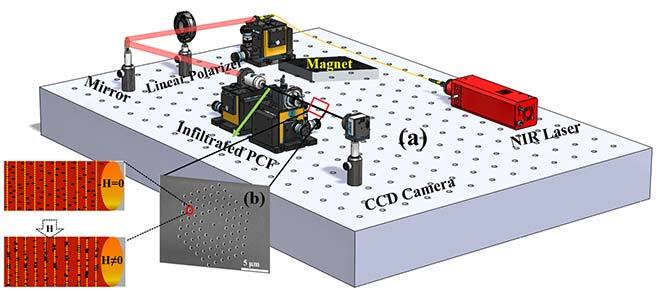
Fig. 1: Schematic illustration of (a) experimental setup, (b) The inset exhibits the arrangement of MNPs in the PCF holes with (bottom image) and without (top image) the application of an external magnetic field.
Influence of MF Concentration
In this experiment, three different concentrations of MF with 5.9, 8.8 and 11.8 Vol.% of magnetic particles were considered. As shown in Fig. 2, the transmitted optical power exhibits a strong dependence with the applied magnetic field strength. The experimental results in Fig. 2 were fitted with a Langevin function with a good degree of confidence (R=0.996). The proposed sensor exhibited a limit of detection ≤ 16 gauss within the effective sensing range (i.e. below saturation point).
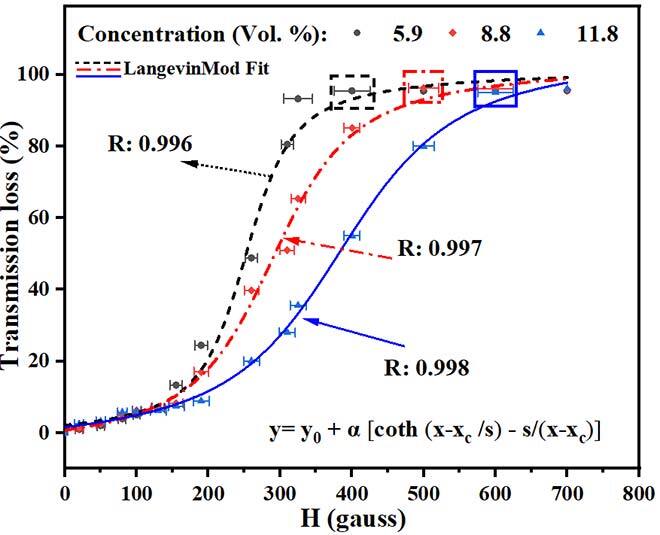
Fig. 2. Transmission loss versus magnetic field for samples with various Vol.% concentration of MNPs.
Dynamic Response of the Sensor
In order to evaluate the dynamic response of our sensor, PCFs were exposed to a constant magnetic field of 250±8.7 gauss three times consecutively. The samples containing the lowest concentration of magnetic particles (5.9 Vol%) exhibited very fast response times (time interval during which the transmitted optical power changes from 90 to 10% of its variation) of 0.1s and recovery times (in reverse of response time definition) of also 0.1s as shown in Fig. 3. In Table 1 we summarized the performance of the main sensing specifications reported in recent literature.
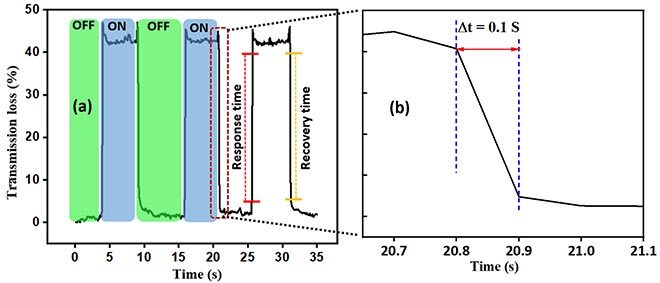
Fig.3. (a) Dynamic response of the infiltrated PCF with 5.9 Vol.% MF in H=250±8.7 gauss, (b) Close-up view with finer resolution of the response time region.
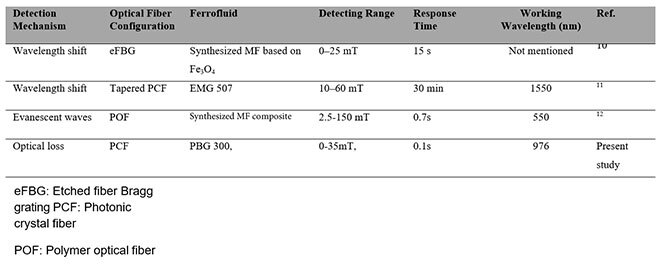
Conclusion
In this work, we propose and demonstrate a new type of magnetic field fiber-optic sensor based on a special type of photonic crystal fiber (PCF), with very small submicron-sized air holes infiltrated with a functional magnetic fluid (MF). The resulting fiber-optic probe allowed us to demonstrate a highly sensitive (0-35 mT), fast (0.1 s response time) and compact magnetic field sensor that can be operated using cost-effective near-infrared laser diodes. The experimental results were well fitted using a Langevin function and explained by a magnetic field and mode-dependent optical transmission model. This demonstration provides another step toward novel hybrid magneto-fluidic fiber-optic sensing approaches for biochemical and environmental sensing applications.
Acknowledgment
The authors would like to thank Mathieu Gratuze for his help in the extraction of simulation data.
Additional Information
For more information on this research, please read the following research paper:
S. Azad, S.K. Mishra, G. Rezaei, R. Izquierdo, B. Ung, Rapid and sensitive magnetic field sensor based on photonic crystal fiber with magnetic fluid infiltrated nanoholes, Scientific Reports 12(1) (2022) 1-8.


